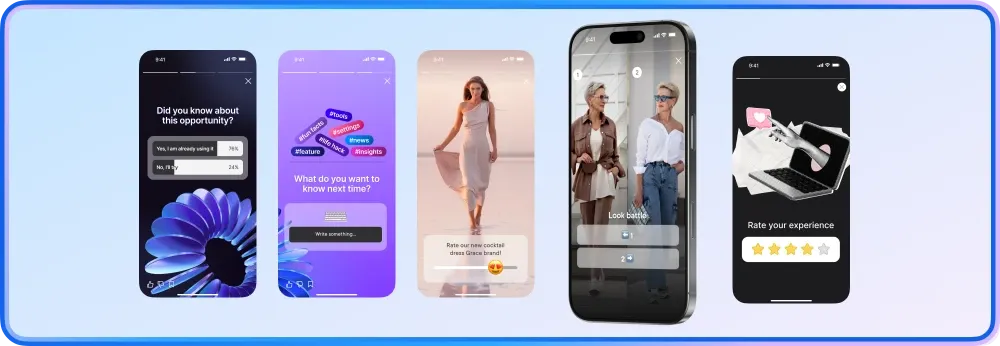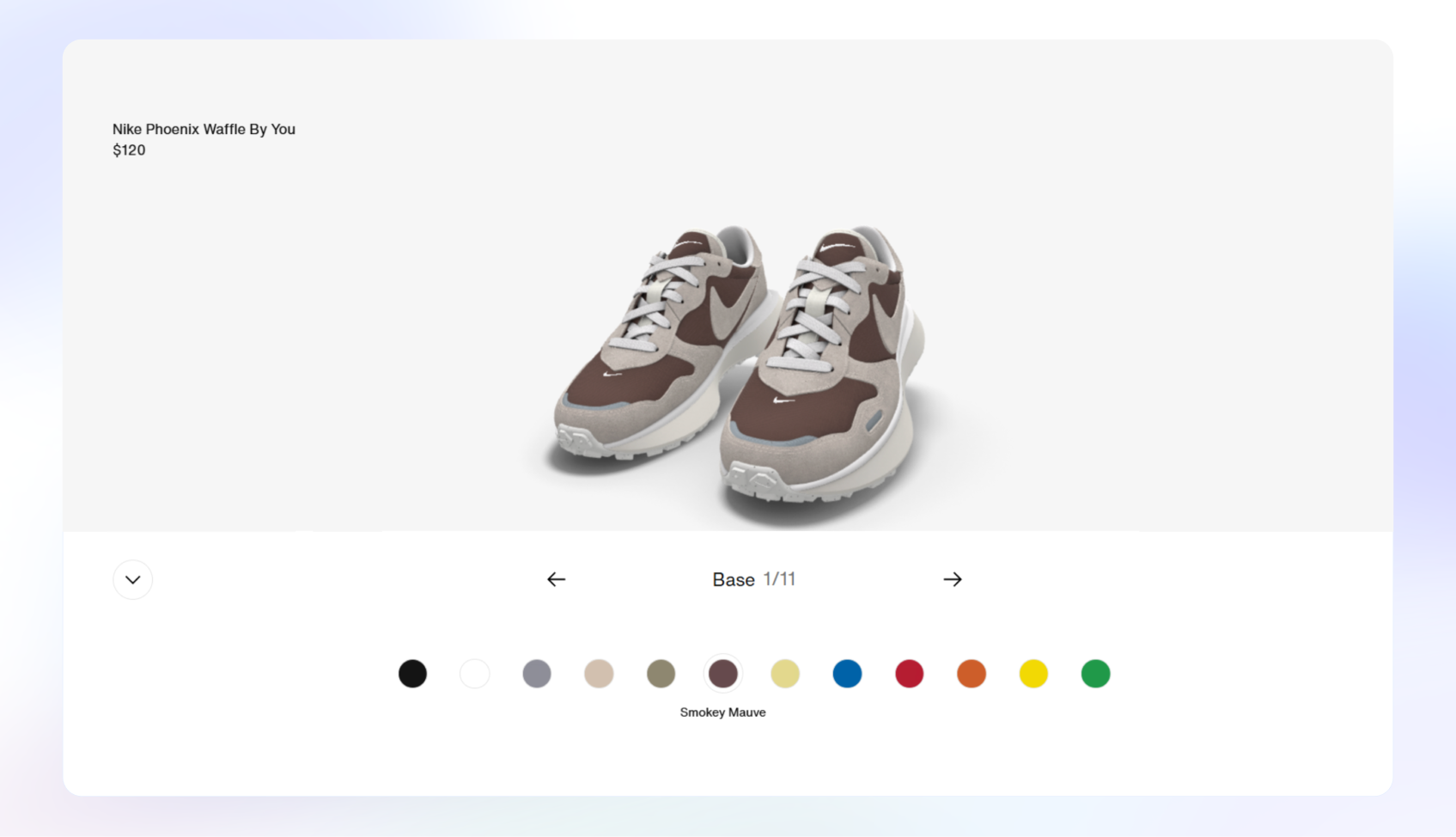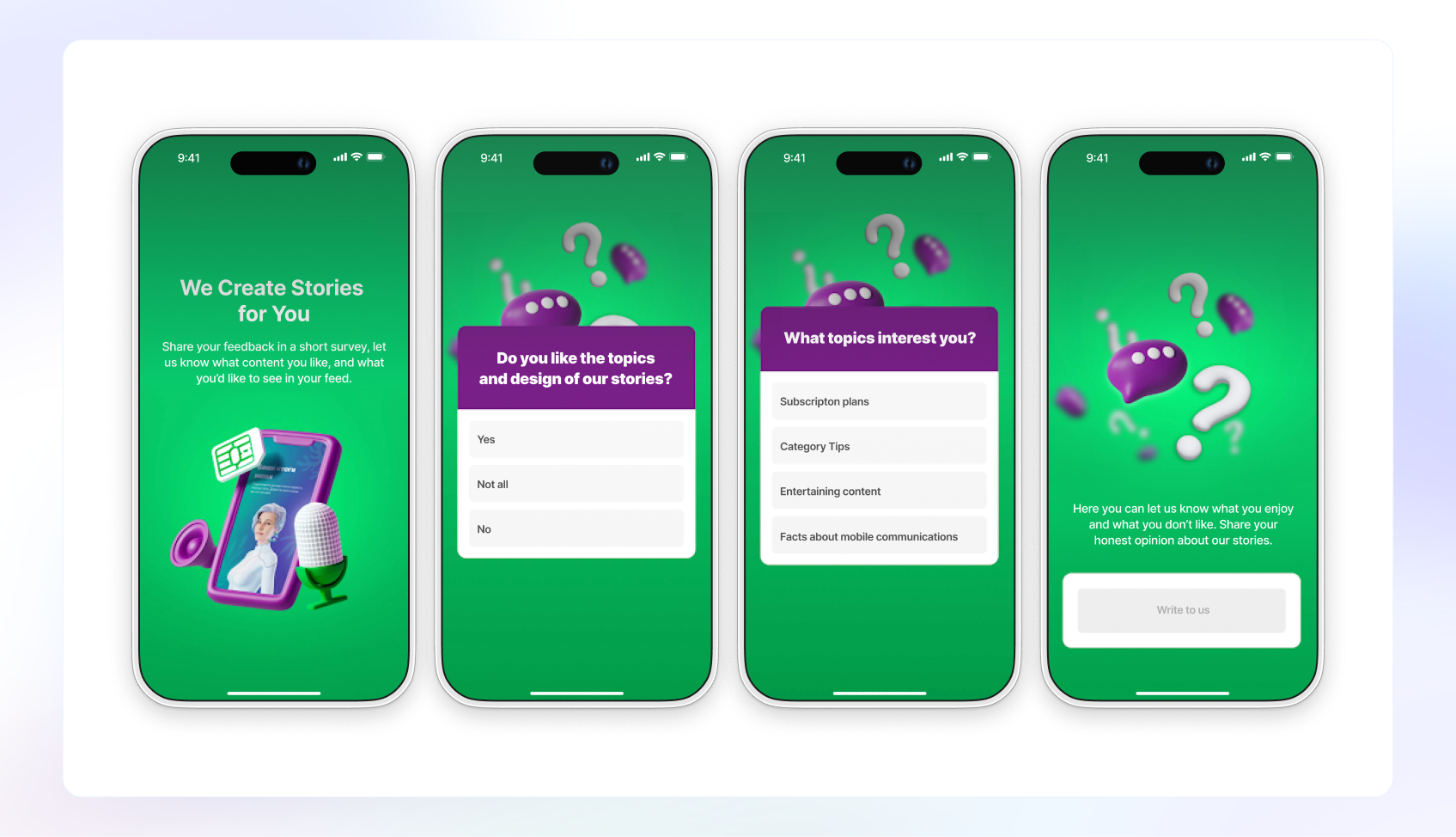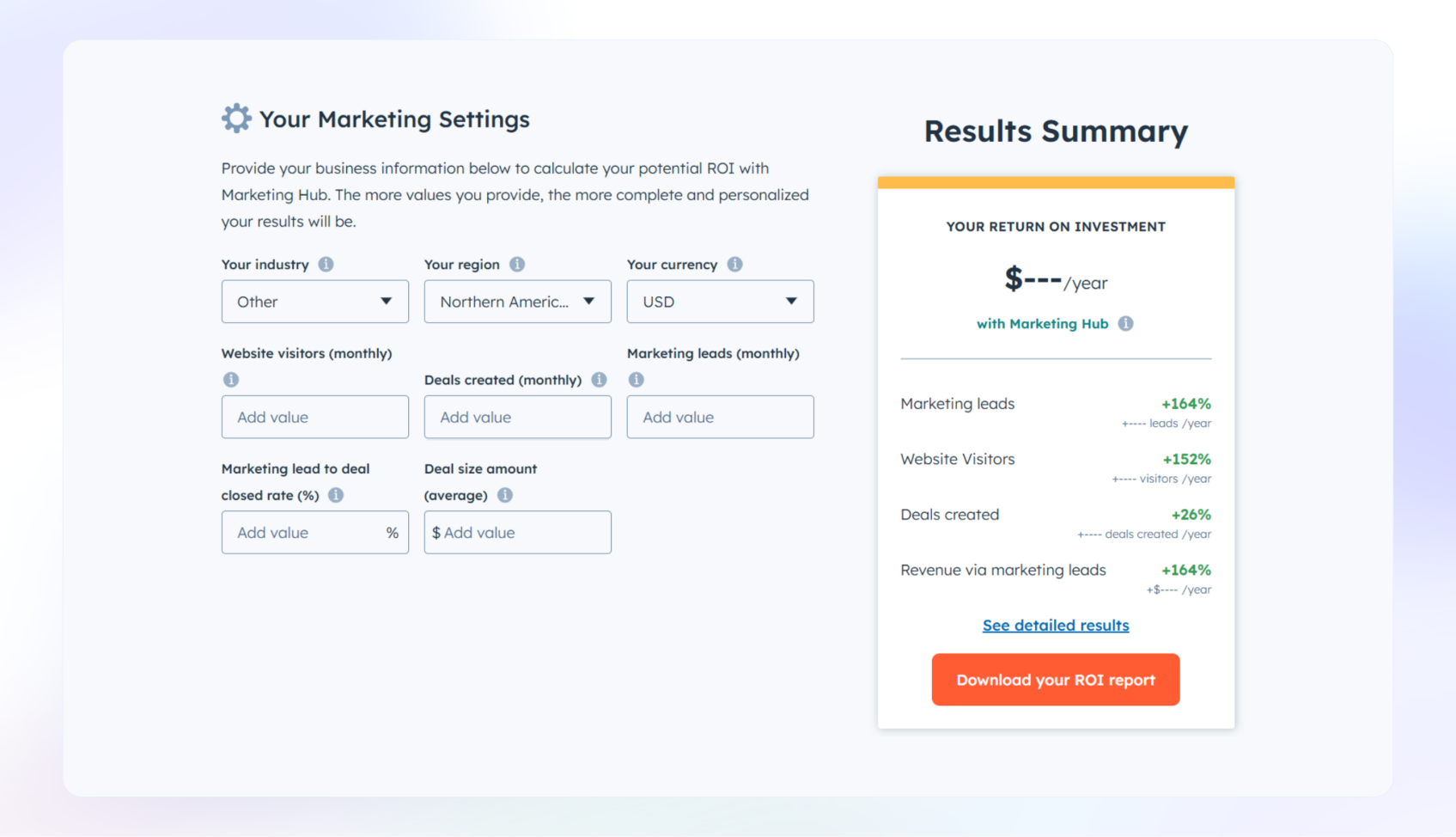.webp?2025-12-17T15:00:29.367Z)
Spotify Wrapped ideas make stats lovable

Interactive Content Marketing: A Friendly Guide for Modern Marketers
Karina
Author @ InAppStory
Let’s keep it simple. Interactive content marketing isn’t about impressing anyone with fancy words. It’s about one thing: helping people connect with your brand on a deeper level.
Below, we’ll define interactive content, show practical examples, offer tips on how to create it, and discuss why it’s especially helpful in a B2B context. Along the way, we’ll reference real data and share honest insights:
✔ What Is Interactive Content?
✔ Difference Between Linear and Interactive Content
✔ B2B Interactive Content
✔ Examples of Interactive Content
✔ How to Create Interactive Content (Step by Step)
✔ Pros and Cons of Interactive Content Development
✔ Key Takeaways
✔ Conclusion
What is Interactive Content?
Definition of Interactive: Interactive content is any digital format that encourages the user to become more involved with the website, application, etc. Instead of passively reading or watching, people click, type, and explore. This is where “interact vs engage” matters.
Engaging content is interesting, but interactive content takes it further by letting the user do something, like answering a quiz or playing with a calculator.
Interactive content marketing simply means using these interactive formats — quizzes, polls, assessments, and more — to promote a brand, service, or product in a way that feels collaborative.
Difference Between Linear and Interactive Content
- Linear Content: You read or watch from start to finish without affecting anything. Think of a traditional blog post or a basic video.
- Interactive Content: You have choices, inputs, or clickable elements that shape your experience. For example, an interactive video content piece where viewers select different story paths, or an interactive article with branching narratives.
Put simply, linear is a one-way street. Interactive is a two-way conversation.
B2B Interactive Content
In B2B interactive content, you deal with decision-makers who value clarity and efficiency. They don’t want generic PDFs. They want an interactive website approach where they can select, filter, or calculate specifics.
Why B2B Interactive Content works
- It saves time: Decision-makers want quick answers. Interactive tools deliver results fast.
- It engages teams: Many B2B decisions involve multiple people. Interactive content can be shared and explored collaboratively.
- It builds trust: Tailored content shows that you understand their challenges, which fosters credibility.
Best Types of Interactive Content for B2B
In B2B, the best interactive content solves problems and makes decision-making easier. Calculators are a prime example. They provide instant, customized answers, like showing cost savings or ROI in seconds. Product configurators go a step further, letting users design solutions tailored to their specific needs.
Interactive infographics are perfect for simplifying complex data. They make it easy to explore and focus on what’s relevant. Videos bring efficiency to the table by letting users skip to what matters most, saving time and effort. Quizzes and surveys also play a key role. They help buyers assess their needs while giving businesses valuable insights in return.
The best interactive content works because it’s practical and tailored. It respects the audience’s time while offering real solutions. Let’s look at some examples to see these types in action and understand why they work so well.
Types of Interactive Content
Interactive content transforms mundane marketing efforts into memorable experiences. Think of it as hosting a lively party where every guest feels involved and entertained, rather than just being a passive observer.
Below you will find examples of interactive content, complete with real-world inspirations and insights drawn from our own experiences.
Interactive Websites
Interactive websites are dynamic pages where users can explore features, click through hotspots, and engage with content in meaningful ways. These experiences are now being transformed by Augmented Reality (AR) and Virtual Reality (VR).
AR/VR can captivate users like nothing else. The harsh truth is that developing these features requires significant investment, and not everyone has the devices to access them. We’ve also noticed that poorly implemented AR/VR can frustrate users more than it helps.
Examples:
- Product Tours: Interactive walkthroughs that allow users to explore different features of a product by clicking on various elements, providing a hands-on experience without leaving the site.
- Virtual Showrooms: 360-degree views of products where users can rotate and explore items from all angles, simulating an in-store experience online.
- Engagement Tools: Features like live chatbots, interactive maps, or user-generated content sections that invite users to participate actively.
Nike’s interactive site stands out. Users customize shoes, picking colors and designs in real time. Now imagine adding AR, where users could see those designs on their feet before buying. It’s brilliant but raises questions. Can smaller companies afford this? Will users with older devices feel left out?

To sum up, we see AR and VR as exciting but not universal tools yet. They’re impressive, but not every website or business needs them. Companies should weigh the cost against the value these features bring to their audience.
Quizzes and Polls
Quizzes and polls are quick, engaging, and perfect for sparking conversations. They remind us of a barista asking your favorite flavors to craft the perfect drink. Simple, personal, and interactive.
Brands love them because a well-crafted quiz or poll builds a connection.
✔ Through interactive polls and surveys, brands can directly ask customers for their preferences, interests, and feedback.
✔ When collecting zero-party data, brands tailor future content and offerings to better meet customer needs, fostering a more personalized experience.
✔ When customers willingly share data, it strengthens trust. They feel in control, which makes the brand-customer relationship more collaborative.

A question to consider is how brands can ensure quizzes and polls stay fresh and engaging without overwhelming users. Striking that balance is key.
Interactive Calculators
Tools for budgeting, ROI estimates, or price comparisons are common in b2b interactive content strategies.
Let’s take HubSpot for example. It provides an ROI calculator that helps businesses estimate the return on investment they can expect from using their marketing tools. This not only engages potential customers but also provides them with tangible reasons to consider HubSpot’s offerings.

Interactive Social Media Posts
Interactive social media posts are the lively gatherings in the vast party of social media.
Polls on LinkedIn: Engage professional audiences and gather feedback directly from industry peers.
Instagram Stories with Interactive Stickers: Quizzes, sliders, and question boxes that encourage followers to interact directly within the story, making the content more engaging and fun.
Facebook Live Q&A Sessions: Live interactions where viewers can ask questions and receive real-time responses, fostering a sense of community and immediacy.
Mind that overuse can feel spammy. Live sessions, if not well-planned, can lose their audience fast. Also, trends change rapidly: what works today might feel outdated tomorrow.
Interactive Video Content
Interactive videos are the digital-age equivalent of choose-your-own-adventure books. They let viewers take control, make choices, and influence the outcome of the story. This transforms passive watching into an engaging and personalized experience.
Examples in action:
- Choose-Your-Own-Adventure Videos: Viewers decide the direction of the story by selecting different options at key points, making each viewing experience unique.
- Clickable Video Overlays: Interactive elements like buttons or hotspots that provide additional information or trigger specific actions within the video, enhancing the storytelling.
- Branching Scenarios: Videos that branch into different paths based on viewer choices, often used in training or educational content to provide a more immersive learning experience.
Why they work:
✔ Immersion and Personalization: Viewers are part of the story, making the experience more memorable and impactful.
✔ Versatility: Whether for entertainment, e-commerce, or education, interactive videos adapt to a wide range of use cases.
A question to reflect on whether interactive videos will become the new standard or remain a niche tool for specific industries. Their potential is vast, but only if creators keep the experience intuitive and rewarding.
⚡ As audiences increasingly favor short-form videos that grab attention quickly and hold it effectively, creators need to focus on delivering quick and engaging experiences. This trend could shape how interactive videos evolve to stay relevant and accessible to a wider audience.
Interactive Infographics
Interactive infographics are the treasure maps that turn static data into a captivating exploration. They transform boring numbers and charts into engaging experiences, allowing users to delve deeper into information through clicks, hovers, and other interactions.
MarketSplash shares that Interactive infographics form an integral part of the strategy for 85% of B2B marketers, whether now or in future plans.
Data Exploration: Users can click on different sections of the infographic to reveal more detailed information or related statistics, providing a deeper understanding of the data.
Dynamic Charts and Graphs: Interactive elements that allow users to manipulate data views, such as changing the time frame or filtering specific categories, making the information more relevant to their interests.
Storytelling Infographics: Combining narrative elements with interactive data points to guide users through a story or process, enhancing the overall narrative with engaging visuals.
How to Create Interactive Content (Step by Step)
If you want to know what real brands like METRO and Deezer achieved using interactive formats, check out our comprehensive article on creating interactive content for mobile apps. Real examples show 15–50% boosts in engagement, CTR, or conversions.
1. Identify Your Goal
Why do you need interactive digital marketing? Lead generation? Brand awareness? Customer education?
2. Pick a Format
- Polls if you want quick opinions.
- Calculators for a more in-depth approach (perfect for interactive marketing content in B2B).
- Interactive articles for storytelling.
- Interactive video content for a more immersive experience.
3. Use the Right Tools
Plenty of interactive content tools exist: Typeform, Ceros, or even specialized interactive content creation software. But selecting the right tool depends on your budget, technical skills, and, most importantly, your audience.
When choosing an interactive content creation tool, ask yourself:
- Can it grow with your needs?
- Is it easy to integrate with your current systems?
- Does it help you create experiences your users will love?
For mobile apps, quizzes and polls are among the most effective types of interactive content. Platforms like InAppStory are specifically designed to integrate this kind of engagement directly into mobile apps. Here’s why they work so well:
- Instant Engagement: Mobile users expect quick and simple interactions. A quiz or poll embedded in an app grabs attention immediately.
- Personalization: Quizzes can deliver tailored results—like recommending products based on user preferences.
- Two-Way Interaction: Polls let users share their opinions in real-time, creating a sense of dialogue between the app and its audience.
Take, for example, a retail app. A quiz could ask questions about a user’s style and suggest outfits based on their answers. A poll might ask for feedback on a new feature or product. It’s simple but effective. Users feel heard, and brands gain insights they can act on.
⚡ According to the E-Commerce Mobile Engagement Report, interactive features like these significantly boost retention and conversion rates. This report is built on insights from 5,000+ examples of in-app visual communication across major global e-commerce platforms.
4. Keep It Simple
Nobody wants a 20-step quiz. Create interactive content that’s quick to use and clear in its purpose. The best engaging content examples don’t confuse people; they guide them smoothly.
5. Track the Data
Look at completion rates, shares, and time spent. This helps you refine your interactive strategy over time.
Pros and Cons of Interactive Content Development
Interactive content offers exciting opportunities to engage and connect with audiences. But, like any strategy, it comes with its own set of strengths and challenges.
Pros
- Deeper Engagement: Users remember brands that let them participate.
- Valuable Data: Interactive content development allows you to gather insights in real time.
- Personalized Experience: Builds stronger connections, especially in B2B interactive content contexts.
Cons
- Cost and Time: High-quality interactive content creation might need extra budget or coding support.
- Potential Friction: Some people might not want to fill out forms or click through multiple steps.
- Maintenance: Interactive tools require updates to stay functional.
Are you prepared to invest in not just creating interactive content, but also maintaining and improving it over time? The answer can shape whether this strategy becomes a competitive edge or a missed opportunity.
Key Takeaways
- Interactive content goes beyond flashy design; it’s about user involvement and tangible value.
- B2B interactive content fosters better lead generation and trust by addressing specific pain points.
- Online content definition is vast, but interactive pieces stand out because they invite participation.
- Always respect your audience. Keep it simple, honest, and data-backed.
- Measure results. You learn a lot from how people click and explore.
Final Thoughts
Remember: writing as you speak doesn’t mean losing professionalism. It means sounding human. Interactive content marketing is about building connections, and your tone is part of that. Keep your user in mind, stay honest, and provide real facts. If you do that, you’ll create interactive material that people genuinely appreciate. That’s the heart of any good marketing strategy — B2B or otherwise.

